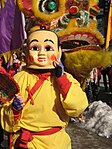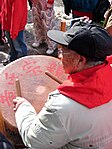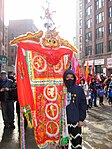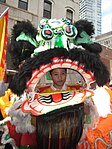Chinatown, Boston: Difference between revisions
photo added |
photo added |
||
| Line 29: | Line 29: | ||
Image:ChineseNewYearBoston04.jpg|[[Chinese New Year]] [[festival]] in Boston's Chinatown |
Image:ChineseNewYearBoston04.jpg|[[Chinese New Year]] [[festival]] in Boston's Chinatown |
||
Image:ChineseNewYearBoston08.jpg|[[Chinese New Year]] [[festival]] in Boston's Chinatown |
Image:ChineseNewYearBoston08.jpg|[[Chinese New Year]] [[festival]] in Boston's Chinatown |
||
Image: |
Image:ChineseNewYearBostonLionDance1.jpg|[[Lion dance]]er at [[Chinese New Year]] [[festival]] in Boston's Chinatown |
||
Image:ChineseNewYearBostonLionDance2.jpg|[[Lion dance]]er at [[Chinese New Year]] [[festival]] in Boston's Chinatown |
Image:ChineseNewYearBostonLionDance2.jpg|[[Lion dance]]er at [[Chinese New Year]] [[festival]] in Boston's Chinatown |
||
Image:Registry of Motor Vehicles.jpg|[[Department of Motor Vehicles|Registry of Motor Vehicles]] on [[Washington Street (Boston)|Washington Street]] in Boston's Chinatown |
Image:Registry of Motor Vehicles.jpg|[[Department of Motor Vehicles|Registry of Motor Vehicles]] on [[Washington Street (Boston)|Washington Street]] in Boston's Chinatown |
||
Revision as of 13:52, 6 February 2009

The only historically Chinese area in New England, Chinatown, Boston is located in downtown Boston, Massachusetts. Centered on Beach Street, the neighborhood borders Boston Common, Downtown Crossing, the South End, and the Southeast Expressway/Massachusetts Turnpike. Tufts Medical Center occupies a space reclaimed by filling a tidal flat; the newly-created area was first settled by White Anglo-Saxon Protestants. After residential properties in this area became less desirable due to railway developments, it was settled by a mixed succession of Irish, Jewish, Italian, Syrian, and Chinese immigrants. Each group replaced the previous one to take advantage of low-cost housing and job opportunities in the area. During the late-nineteenth century, garment manufacturing plants also moved into Chinatown, creating Boston's historic garment district. The garment district was active until the 1990s.
Negotiations resulted in the provision of funds for the construction of new community housing in Chinatown. During this period, city officials also designated an area adjacent to Chinatown as Boston's red light district, also known as the Combat Zone. However, the Combat Zone virtually disappeared by the 1990s, due to city pressure and a general increase in property values, encouraging building sales and the removal of former tenants.
Modern day
Chinatown remains a center of Asian-American life in New England, hosting many Chinese, Japanese, Cambodian, and Vietnamese restaurants and markets. Chinatown is one of Boston's most densely-populated residential districts, with over 28,000 people per square mile in the year 2000. Nearly 70% of Chinatown's population is Asian, with a median household income of $14,289.

The traditional Chinatown Gate (paifang) with a foo lion on each side is located at the intersection of Beach Street and Surface Road. Once a run-down area housing little more than a ventilation-fan building for the Central Artery Tunnel, a garden was constructed at this site as part of the Big Dig project. The Gate is visible from the South Station Bus Terminal and is a popular tourist destination and photo opportunity.
The non-profit community newspaper Sampan provides English-language news and information about Chinatown.
Housing development and gentrification
Currently, Chinatown is experiencing gentrification. Large luxury residential towers are built in and surrounding an area that was, by and large, small three-to-five-story apartment buildings intermixed with retail and light-industrial spaces. A property developer has purchased the Dainty Dot Hosiery building, which is listed in the National Register of Historic Places, with plans to transform it into condominiums. Chinese community organizations such as the Asian Community Development Corporation are also building housing developments which offer mixed- and low-income housing.
Transportation
Chinatown has excellent local and regional transportation connections. It is served by the MBTA's Red Line, Silver Line, and Commuter Rail at South Station and the Orange Line at Chinatown Station. Interstate 93 and the Massachusetts Turnpike are also in close proximity. Two Chinese-owned bus services (Fung Wah and Lucky Star/Travelpack) provide hourly connections with New York's Chinatown.
Chinatown South
In recent years, a new satellite Chinatown has been rapidly emerging approximately 10 miles (16 km) to the south, on Hancock Street in the neighboring city of Quincy. This is due to the rapid influx of Hokkien-speaking Mainland Chinese immigrants from the province of Fujian, as well as a large and growing ethnic Vietnamese population. There are already several large Asian supermarkets such as the Kam Man Foods and Super 88 supermarket chains, and other businesses that are competing with Boston's Chinatown. Several businesses operating in Chinatown now have branches in Quincy.
Gallery
-
Chinese New Year festival in Boston's Chinatown
-
Chinese New Year festival in Boston's Chinatown
-
Chinese New Year festival in Boston's Chinatown
-
Chinese New Year festival in Boston's Chinatown
-
Chinese New Year festival in Boston's Chinatown
-
Chinese New Year festival in Boston's Chinatown
-
Registry of Motor Vehicles on Washington Street in Boston's Chinatown
-
Chinese New Year festival in Boston's Chinatown
-
Chinese New Year festival in Boston's Chinatown
-
Cathay Bank in Boston's Chinatown
References
- Chinatown Park
- Chinatown Profile Census 2000
- Developer buys historic Hub textile building for $9m, plans residences
See also
External links
- [1] New Guide to Boston's Chinatown
- Boston Chinatown Neighborhood Center
- Asian American Civic Association
- Asian Community Development Corporation
- Chinatown Heritage Project
- Historical Records of The International Society created to support Chinese culture and heritage among Boston's Chinese community, are available in the Archives and Special Collections of the Northeastern University Libraries in Boston, MA.
- Patriot Ledger Special Report: Chinatown South












